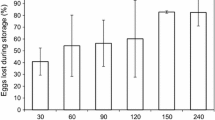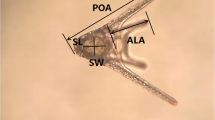Abstract
The effects of light and short-term temperature elevation on the 48-h egg hatching success (HS) of cold-stored (2 °C) Acartia tonsa Dana (Copepoda: Calanoida) eggs were examined in the present study. The eggs can be stored for up to 7.5 months and maintain their high hatching rate under optimal conditions. Intensively produced eggs from the copepod A. tonsa may be hatched and used as an inoculum for producing copepod nauplii as live feed for fish larvae. The HS for eggs that were directly exposed to LED light declined rapidly after 1 month of storage (from 91 to 25 %), and these eggs did not hatch at all after 3 months of storage. The highest HS found was for eggs stored in complete darkness. The HS for eggs stored in normoxic (≥7 mg DO L−1) and anoxic (≤0.03 mg DO L−1) seawater was not affected by short-term temperature transitions from 2 °C up to 9 or 17 °C for a period of 12 or 24 h, when hatched 1 week post-exposure. The global mean HS for eggs stored in normoxic seawater was 85.9 % and significantly lower compared to eggs stored under anoxic conditions after 3 weeks of storage (91.8 %) (P = 0.001; SNK).


Similar content being viewed by others
References
Alekseev V, Ravera O, Stasio B (2007) Introduction to Diapause. In: Alekseev V, Stasio B, Gilbert J (eds) Diapause in aquatic invertebrates theory and human use. Springer, Netherlands, pp 3–10
Baker EP, Alves D, Bengtson DA (1998) Effects of rotifer and Artemia fatty-acid enrichment on survival, growth and pigmentation of summer flounder Paralichthys dentatus larvae. J World Aquac Soc 29:494–498
Béjà O, Aravind L, Koonin EV, Suzuki MT, Hadd A, Nguyen LP, Jovanovich SB, Gates CM, Feldman RA, Spudich JL, Spudich EN, DeLong EF (2000) Bacterial rhodopsin: evidence for a new type of phototrophy in the sea. Science 289:1902–1906
Bell JG, McEvoy LA, Estevez A, Shields RJ, Sargent JR (2003) Optimising lipid nutrition in first-feeding flatfish larvae. Aquaculture 227:211–220
Berggreen U, Hansen B, Kiørboe T (1988) Food size spectra, ingestion and growth of the copepod Acartia tonsa during development: implications for determination of copepod production. Mar Biol 99:341–352
Chen F, Marcus NH (1997) Subitaneous, diapause, and delayed-hatching eggs of planktonic copepods from the northern Gulf of Mexico: morphology and hatching success. Mar Biol 127:587–597
Davison EA Jr, Stross RG (1986) A blue light-reversible reaction in an animal system (Daphnia pulex). Experientia 42:620–622
de Figueiredo DR, Azeiteiro UM, Esteves SM, Gonçalves FJM, Pereira MJ (2004) Microcystin-producing blooms—a serious global public health issue. Ecotoxicol Environ Saf 59:151–163
de la Torre JR, Christianson LM, Béjà O, Suzuki MT, Karl DM, Heidelberg J, DeLong EF (2003) Proteorhodopsin genes are distributed among divergent marine bacterial taxa. Proc Natl Acad Sci 100:12830–12835
Drillet G, Iversen MH, Sørensen TF, Ramløv H, Lund T, Hansen BW (2006) Effect of cold storage upon eggs of a calanoid copepod, Acartia tonsa (Dana) and their offspring. Aquaculture 254:714–729
Drillet G, Frouël S, Sichlau MH, Jepsen PM, Højgaard JK, Joarder AK, Hansen BW (2011a) Status and recommendations on marine copepod cultivation for use as live feed. Aquaculture 315:155–166
Drillet G, Rabarimanantsoa T, Frouël S, Lamson J, Christensen A, Kim-Tiam S, Hansen B (2011b) Do inactivated microbial preparations improve life history traits of the copepod Acartia tonsa? Mar Biotechnol 13:831–836
Evjemo JO, Olsen Y (1997) Lipid and fatty acid content in cultivated live feed organisms compared to marine copepods. Hydrobiologia 358:159–162
Evjemo JO, Reitan KI, Olsen Y (2003) Copepods as live food organisms in the larval rearing of halibut larvae (Hippoglossus hippoglossus L.) with special emphasis on the nutritional value. Aquaculture 227:191–210
Gomez-Consarnau L, Gonzalez JM, Coll-Llado M, Gourdon P, Pascher T, Neutze R, Pedros-Alio C, Pinhassi J (2007) Light stimulates growth of proteorhodopsin-containing marine Flavobacteria. Nature 445:210–213
Hagiwara A, Hoshi N, Kawahara F, Tominaga K, Hirayama K (1995) Resting eggs of the marine rotifer Brachionus plicatilis Müller: development, and effect of irradiation on hatching. Hydrobiologia 313–314:223–229
Hansen BW, Drillet G (2013) Comparative oxygen consumption rates of subitaneous and delayed hatching eggs of the calanoid copepod Acartia tonsa (Dana). J Exp Mar Biol Ecol 442:66–69
Helvik JV, Walther BT (1992) Photo-regulation of the hatching process of halibut (Hippoglossus hippoglossus) eggs. J Exp Zool 263:204–209
Hoff FH, Snell TW (1987) Plankton culture manual. Florida Aqua Farms, Inc, p 126
Højgaard JK, Jepsen PM, Hansen BW (2008) Salinity-induced quiescence in eggs of the calanoid copepod Acartia tonsa (Dana): a simple method for egg storage. Aquac Res 39:828–836
Holmstrup M, Overgaard J, Sørensen TF, Drillet G, Hansen BW, Ramløv H, Engell-Sørensen K (2006) Influence of storage conditions on viability of quiescent copepod eggs (Acartia tonsa Dana): effects of temperature, salinity and anoxia. Aquac Res 37:625–631
Invidia M, Sei S, Gorbi G (2004) Survival of the copepod Acartia tonsa following egg exposure to near anoxia and to sulfide at different pH values. Mar Ecol Prog Ser 276:187–196
Jacquet C, Thermes V, Luze Ad, Puiseux-Dao S, Bernard C, Joly J-S, Bourrat F, Edery M (2004) Effects of microcystin-LR on development of medaka fish embryos (Oryzias latipes). Toxicon 43:141–147
Kiørboe T, Møhlenberg F, Hamburger K (1985) Bioenergetics of the planktonic copepod Acartia tonsa: relation between feeding, egg production and respiration, and the composition of specific dynamic action. Mar Ecol Prog Ser 26:85–97
Landry MR (1975) Dark inhibition of egg hatching of the marine copepod Acartia clausi Giesbr. J Exp Mar Biol Ecol 20:43–47
Li K, Kjørsvik E, Bergvik M, Olsen Y (2014) Manipulation of the fatty acid composition of phosphatidylcholine and phosphatidylethanolamine in rotifers Brachionus Nevada and Brachionus Cayman. Aquac Nutr n/a–n/a
Linden A, Vankerckhoven I, Caubergs R, Decleir W (1986) Action spectroscopy of light-induced hatching of Artemia cysts (Branchiopoda: Crustacea). Mar Biol 91:239–243
Malbrouck C, Kestemont P (2006) Effects of microcystins on fish. Environ Toxicol Chem 25:72–86
Mauchline J (1998) The Biology of Calanoid Copepods: the biology of Calanoid Copepods (advances in marine biology, Vol. 33). Elsevier Academic Press, NewYork, p 710
Morris RJ, Williams DE, Luu HA, Holmes CFB, Andersen RJ, Calvert SE (2000) The adsorption of microcystin-LR by natural clay particles. Toxicon 38:303–308
Ohs CL, Rhyne AL, Stenn E (2009) Viability of subitaneous eggs of the copepod, Acartia tonsa (Dana), following exposure to various cryoprotectants and hypersaline water. Aquaculture 287:114–119
Paffenhoefer G-A, Stearns DE (1988) Why is Acartia tonsa (Copepoda: Calanoida) restricted to nearshore environments? Mar Ecol Prog Ser Oldend 42:33–38
Peck MA, Holste L (2006) Effects of salinity, photoperiod and adult stocking density on egg production and egg hatching success in Acartia tonsa (Calanoida: Copepoda): optimizing intensive cultures. Aquaculture 255:341–350
Peck MA, Ewest B, Holste L, Kanstinger P, Martin M (2008) Impacts of light regime on egg harvests and 48-h egg hatching success of Acartia tonsa (Copepoda: Calanoida) within intensive culture. Aquaculture 275:102–107
Rainuzzo JR, Reitan KI, Olsen Y (1994) Effect of short- and long-term lipid enrichment on total lipids, lipid class and fatty acid composition in rotifers. Aquac Int 2:19–32
Rønnestad I, Helland S, Lie Ø (1998) Feeding Artemia to larvae of Atlantic halibut (Hippoglossus hippoglossus L.) results in lower larval vitamin A content compared with feeding copepods. Aquaculture 165:159–164
Rønnestad I, Thorsen A, Finn RN (1999) Fish larval nutrition: a review of recent advances in the roles of amino acids. Aquaculture 177:201–216
Salvesen I, Vadstein O (1995) Surface disinfection of eggs from marine fish: evaluation of four chemicals. Aquac Int 3:155–171
Salvesen I, Øie G, Vadstein O (1997) Surface disinfection of Atlantic halibut and turbot eggs with glutaraldehyde: evaluation of concentrations and contact times. Aquac Int 5:249–258
Sorgeloos P (1973) First report on the triggering effect of light on the hatching mechanism of Artemia salina dry cysts. Mar Biol 22:75–76
Stearns DE, Forward RB Jr (1984) Photosensitivity of the calanoid copepod Acartia tonsa. Mar Biol 82:85–89
Støttrup JG (2000) The elusive copepods: their production and suitability in marine aquaculture. Aquac Res 31:703–711
Støttrup JG, McEvoi LAE (2003) Live feeds in marine aquaculture. Blackwell Science, Oxford, pp 145–205
Støttrup JG, Norsker NH (1997) Production and use of copepods in marine fish larviculture. Aquaculture 155:231–247
Støttrup JG, Richardson K, Kirkegaard E, Pihl NJ (1986) The cultivation of Acartia tonsa Dana for use as a live food source for marine fish larvae. Aquaculture 52:87–96
Uye S (1985) Resting egg production as a life history strategy of marine planktonic copepods. Bull Mar Sci 37:440–449
Uye S, Fleminger A (1976) Effects of various environmental factors on egg development of several species of Acartia in Southern California. Mar Biol 38:253–262
Uye S, Kasahara S, Onbé T (1979) Calanoid copepod eggs in sea-bottom muds. IV. Effects of some environmental factors on the hatching of resting eggs. Mar Biol 51:151–156
van der Meeren T, Naas KE (1997) Development of rearing techniques using large enclosed ecosystems in the mass production of marine fish fry. Rev Fish Sci 5:367–390
van der Meeren T, Olsen RE, Hamre K, Fyhn HJ (2008) Biochemical composition of copepods for evaluation of feed quality in production of juvenile marine fish. Aquaculture 274:375–397
Walne PR (1974) Culture of bivalve mollusks: 50 Years experience at Conwy. Fishing News Books, p 189
Williams R, Conway DVP, Hunt HG (1994) The role of copepods in the planktonic ecosystems of mixed and stratified waters of the European shelf seas. Hydrobiologia 292–293:521–530
Yutin N, Suzuki MT, Béjà O (2005) Novel primers reveal wider diversity among marine aerobic anoxygenic phototrophs. Appl Environ Microbiol 71:8958–8962
Acknowledgments
Thanks are due to Zsolt Volent for performing the light measurements. This research was supported and funded by The Norwegian Seafood Research Fund (FHF) project “LeppeProd.”
Author information
Authors and Affiliations
Corresponding author
Rights and permissions
About this article
Cite this article
Hagemann, A., Øie, G., Evjemo, J.O. et al. Effects of light and short-term temperature elevation on the 48-h hatching success of cold-stored Acartia tonsa Dana eggs. Aquacult Int 24, 57–68 (2016). https://doi.org/10.1007/s10499-015-9908-5
Received:
Accepted:
Published:
Issue Date:
DOI: https://doi.org/10.1007/s10499-015-9908-5




